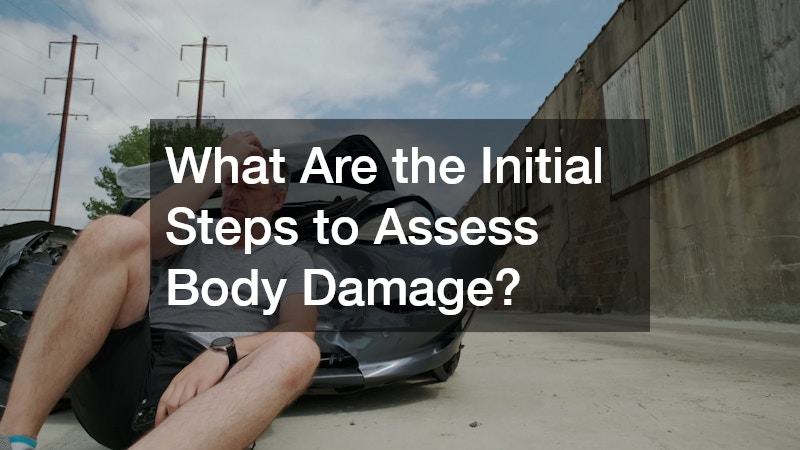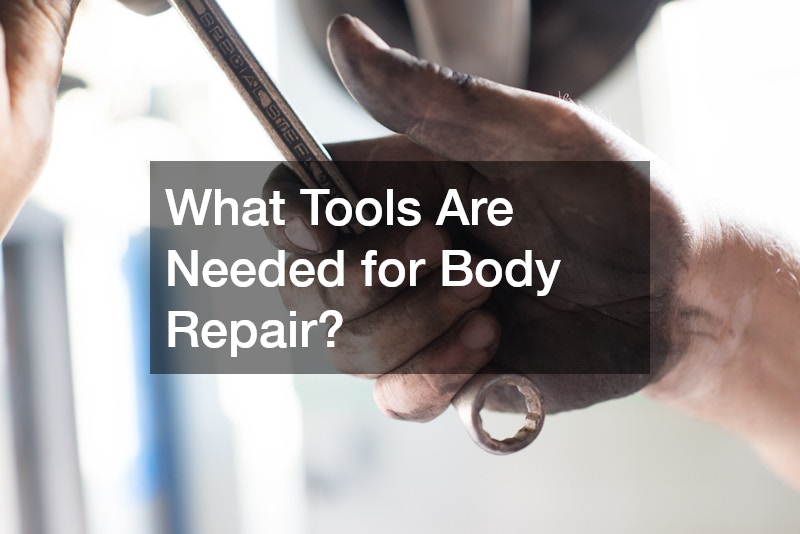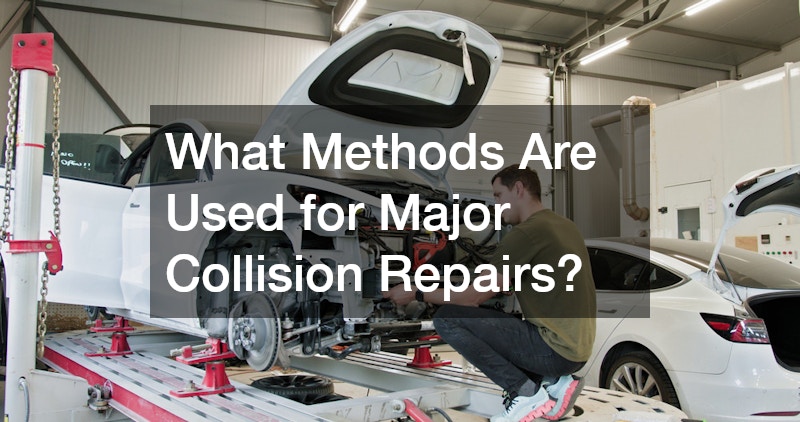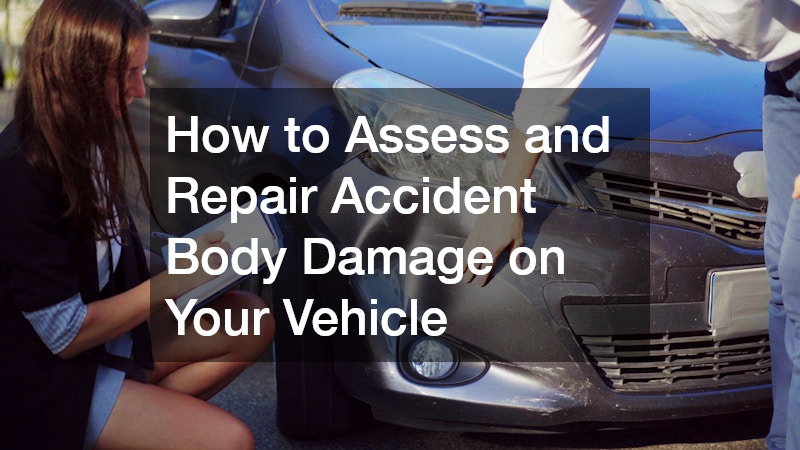
Accidents happen, and when they do, dealing with body damage to your vehicle can be overwhelming. From minor dents to major collisions, understanding how to assess and repair your car ensures both safety and long-term value. This guide provides step-by-step advice on evaluating damage, deciding between DIY repairs or professional help, and navigating insurance claims. It also explores essential tools, methods, and maintenance strategies that every car owner should know. Whether you’re a first-time car owner or an experienced driver, having a clear plan for handling accident body damage can save time, money, and stress.
What Are the Initial Steps to Assess Body Damage?

Inspecting for Visible Damage
The first step in handling accident body damage is to perform a thorough visual inspection. Walk around your vehicle and carefully examine each panel, bumper, and fender for dents, scratches, and misalignments. Take note of any broken lights, cracked glass, or loose trim. A systematic approach ensures you don’t overlook obvious issues that may worsen over time. Local towing companies can safely transport your vehicle using a properly installed hitch for towing to prevent further damage.
Checking for Hidden Damage
Not all damage is immediately apparent. Hidden issues can include bent frames, damaged suspension components, or leaks from the engine or transmission. Pay close attention to tire alignment and unusual noises when moving the car. Hidden damage can pose significant safety risks if left unaddressed, so recognizing early signs is crucial.
Documenting the Damage
Proper documentation is essential for insurance purposes and for planning repairs. Take clear photos of each damaged area from multiple angles. Write detailed notes describing the type and location of the damage. Keeping this record will make interactions with local towing companies, insurance adjusters, and auto repair shops smoother.
Safety Precautions While Assessing
Always prioritize safety during inspection. Ensure the vehicle is on a flat surface with the parking brake engaged. Avoid leaning into sharp or jagged areas and use gloves to protect your hands. If any fluids are leaking, avoid contact and clean up immediately to prevent hazards.
Calling a Professional for Severe Damage
WCalling a Professional for Severe Damage
When damage is extensive, such as significant frame bending or deployed airbags, calling a professional is essential. Local towing companies can safely transport the vehicle to a repair facility using a properly installed hitch for towing, reducing the risk of further damage. Ensuring the vehicle is secured during transit protects delicate components and prevents worsening of dents, scratches, or alignment issues, giving auto repair shops a safer starting point for repairs.
How Do You Determine the Extent of the Damage?
Using Professional Assessment Tools
Auto repair shops and technicians have specialized tools to evaluate damage accurately. Frame alignment machines, diagnostic scanners, and ultrasonic devices reveal problems that are invisible to the naked eye. Utilizing these tools early helps prevent complications during repairs.
Understanding Damage Categories
Damage is typically categorized as minor, moderate, or major. Minor damage includes small dents and scratches, while moderate damage may involve panel deformation or broken lights. Major damage often affects structural integrity, requiring extensive repairs or part replacements. Categorizing the damage correctly guides repair decisions.
The Role of an Insurance Adjuster
Insurance adjusters evaluate vehicle damage to determine coverage. They rely on the documentation you provide, in addition to their own inspections. Understanding their role ensures you communicate effectively and helps prevent delays in claims processing.
Estimating Repair Costs
Repair costs vary depending on the severity of damage, type of vehicle, and choice of repair shop. Local auto repairs may offer more competitive rates than dealership services. Comparing estimates from multiple providers ensures you receive fair pricing while maintaining quality.
Deciding Between Repair and Replacement
Sometimes, repairing a damaged component is less economical than replacement. For instance, replacing a severely dented door or cracked bumper may provide a longer-lasting solution. Consulting with a trusted auto repair shop or tire shops can help determine the most cost-effective approach.
What Tools Are Needed for Body Repair?

Basic Repair Kits
For minor dent and scratch repairs, basic kits are sufficient. These include items such as rubber mallets, suction pullers, sanding blocks, and touch-up paint. DIY enthusiasts can address superficial damage with minimal investment.
Advanced Repair Equipment
Major repairs require more advanced tools, including welding machines, frame straighteners, and pneumatic hammers. Professional auto repair shops maintain these tools for precise, long-lasting results. Renting or purchasing such equipment without experience is generally discouraged.
Safety Gear and Precautions
Protective equipment, including gloves, goggles, and respirators, is essential when performing repairs. Sparks, chemicals, and debris pose serious risks. Always follow safety guidelines to prevent injury during bodywork.
Where to Purchase Tools
Tools for body repair can be obtained from automotive supply stores, local tire shops, or online marketplaces. For those seeking quality assurance, purchasing from reputable suppliers ensures durability and effectiveness.
Tool Maintenance and Storage
Proper care extends the life of your tools. Clean and store them in a dry, organized space. Regular inspection and maintenance prevent malfunctions and ensure safe operation when repairs are needed.
How Can You Repair Minor Dents and Scratches?
Identifying Minor Damages
Minor damages are typically cosmetic and do not affect the vehicle’s structural integrity. Small dents from parking lot mishaps or scratches from tree branches fall into this category. Identifying them early prevents rust or further deterioration.
The Process of Dent Removal
Dent removal involves using suction pullers, dent rods, or paintless dent repair techniques. Carefully applying pressure and heat can restore the panel’s original shape. Precision is key to avoiding additional damage during the process.
Repairing Scratches Effectively
Surface scratches can often be addressed with polishing compounds or touch-up paint. Deeper scratches may require sanding and repainting. Following manufacturer instructions ensures color matching and a seamless finish.
DIY Methods vs. Professional Help
DIY repairs save money for minor issues, but professional intervention is recommended for complex damage. Auto repair shops have the expertise to restore your vehicle fully, which is especially important if resale value or warranty considerations are involved.
Quality Assurance and Testing
After repairs, inspect your work thoroughly. Check alignment, surface smoothness, and paint consistency. Test the vehicle for proper operation, paying attention to doors, lights, and suspension. Ensuring quality at this stage prevents further complications from accident body damage.
What Methods Are Used for Major Collision Repairs?

Structural Repairs and Realignment
Severe accidents often compromise a vehicle’s frame. Structural repairs involve realigning bent sections, replacing support beams, and ensuring proper load distribution. Precision machinery is used to restore factory specifications.
Advanced Welding and Metal Work
Damaged panels or components may require welding or custom metal work. Professionals use advanced techniques to ensure strength and durability while maintaining the vehicle’s original contours.
Replacing Body Panels
When panels are beyond repair, replacement is necessary. Doors, fenders, bumpers, and hoods can be sourced from dealerships or reputable local auto repairs. Proper installation ensures safety and appearance.
Integration of New Components
Modern vehicles often include integrated sensors, cameras, or wiring within body panels. Professional repair ensures these systems function correctly after replacement and helps prevent further accident body damage. Local towing companies and auto repair shops work together to coordinate complex repairs efficiently.
Post-repair Inspection
After major repairs, a comprehensive inspection verifies structural integrity, alignment, and system functionality. This step confirms that your vehicle is safe and roadworthy, preventing future problems.
How Do You Approach Repainting Damaged Areas?
Preparing the Surface
Surface preparation is crucial for paint adhesion. Sanding, priming, and cleaning the area removes imperfections and contaminants. Proper preparation ensures a smooth, long-lasting finish.
Choosing the Right Paint
Matching the original paint color is essential for aesthetics. Automotive paint suppliers and local auto repairs offer color codes and expert advice. Using high-quality paint prevents fading and peeling.
Application Techniques
Spray guns, rollers, or brushes can be used depending on the damage size. Even application and multiple thin coats reduce the risk of streaking or runs. Patience and attention to detail yield professional results.
Dealing With Paint Imperfections
Minor imperfections like bubbles or dust can occur during painting. Wet sanding and buffing correct these issues, restoring a flawless surface. Professionals often perform this step for high-quality results.
Protecting the New Paint Job
Applying clear coats and wax protects against UV damage, corrosion, and environmental hazards. Regular maintenance preserves the vehicle’s appearance for years to come.
What Role Does Regular Maintenance Play in Damage Prevention?
Routine Inspections for Early Detection
Regular inspections help identify issues before they escalate. Checking tire condition, suspension components, and body panels allows timely intervention. Tire shops and local auto repairs can provide inspection services to maintain vehicle integrity.
Protective Measures for Paintwork
Applying protective films, sealants, or coatings shields paint from scratches and environmental damage. Maintaining a clean exterior reduces wear and enhances longevity.
Driving Habits that Reduce Damage Risk
Avoiding aggressive maneuvers, maintaining safe following distances, and careful parking reduces the likelihood of body damage. Mindful driving minimizes the need for costly repairs.
Understanding Environmental Impacts
Weather, road conditions, and exposure to chemicals can accelerate wear. Parking in shaded or covered areas and avoiding harsh roads reduces potential harm.
Scheduling Professional Maintenance
Periodic professional maintenance at auto repair shops ensures that all systems, including suspension, brakes, and body components, remain in optimal condition. Timely service prevents minor issues from becoming major repairs.
How Do Insurance Claims Work for Vehicle Body Damage?

Filing a Claim Process
Filing an insurance claim involves reporting the accident, providing documentation, and submitting repair estimates. Local towing companies can assist in safely transporting damaged vehicles for inspection.
Understanding Insurance Coverage
Not all repairs may be covered, depending on your policy. Familiarize yourself with coverage limits, deductibles, and exclusions. Knowing your policy protects against surprises and helps plan repairs effectively.
Working With Adjusters
Insurance adjusters evaluate the damage and approve repair estimates. Clear communication, documentation, and honesty facilitate smooth processing and reduce delays.
Choosing an Approved Repair Shop
Many insurers maintain a network of approved shops. Selecting a recommended provider may simplify claims and ensure quality standards are met. Local auto repairs and tire shops can also work with insurers for approved services.
Dealing With Claim Dispute Resolutions
Occasionally, an insurance claim denial may occur, or claims may be undervalued. Hiring a personal injury attorney or consulting attorneys experienced in auto claims can help resolve disputes related to accident body damage. A traffic ticket lawyer may also provide guidance if violations contributed to the accident.
What Are the Costs Associated With Body Damage Repair?
Factors Affecting Repair Costs
Repair costs depend on damage severity, vehicle make, and labor rates. Parts replacement, paint quality, and specialized tools all contribute to the final bill.
Getting Estimates From Multiple Providers
Obtaining estimates from local auto repairs, auto repair shops, and tire shops ensures competitive pricing. Comparing quotes allows you to make informed decisions without compromising quality.
Understanding Billing Practices
Some shops charge flat rates, while others bill hourly. Knowing the billing method prevents surprises and ensures transparency during the repair process.
Options for Financing Repairs
For extensive repairs, financing options may be available through repair shops or credit programs. This flexibility allows timely repairs without causing financial strain.
Warranty and Guarantees
Reputable repair providers offer warranties on workmanship and parts. Verifying these guarantees protects your investment and ensures peace of mind.
When Should You Choose a Professional Over DIY?
Evaluating the Complexity of Damage
Complex structural or electronic damage typically requires professional intervention. DIY repairs are best reserved for minor dents or scratches that don’t compromise safety.
Considerations for Time and Expertise
Professional auto repair shops have the experience and equipment to complete repairs efficiently. Attempting advanced repairs without expertise can result in additional costs and extended downtime.
Benefit Analysis of Professional Work
Professional repairs provide higher quality, longer-lasting results, and compliance with safety standards. Engaging experienced technicians enhances resale value and overall satisfaction.
Risks Associated With DIY Repairs
Incorrect repairs can worsen damage, affect vehicle safety, or void warranties. Understanding these risks helps car owners make informed choices about DIY versus professional solutions.
Locating Qualified Professionals
Local towing companies, auto repair shops, tire shops, and mechanics with verified credentials are reliable resources. Recommendations from insurance providers or personal referrals also help identify trustworthy professionals.
Properly assessing and repairing accident body damage is vital for vehicle safety, performance, and longevity. From minor scratches to major collisions, knowing the steps for evaluation, repair, and insurance navigation ensures you make informed decisions. Using the right tools, seeking professional assistance when necessary, and maintaining regular inspections prevent further damage and preserve your investment. Whether you opt for DIY methods for minor issues or rely on local auto repairs and towing services for complex damage, understanding these processes equips every car owner to handle accident-related repairs with confidence. By staying informed and proactive, you can protect your vehicle, minimize repair costs, and ensure safe driving after any accident.

